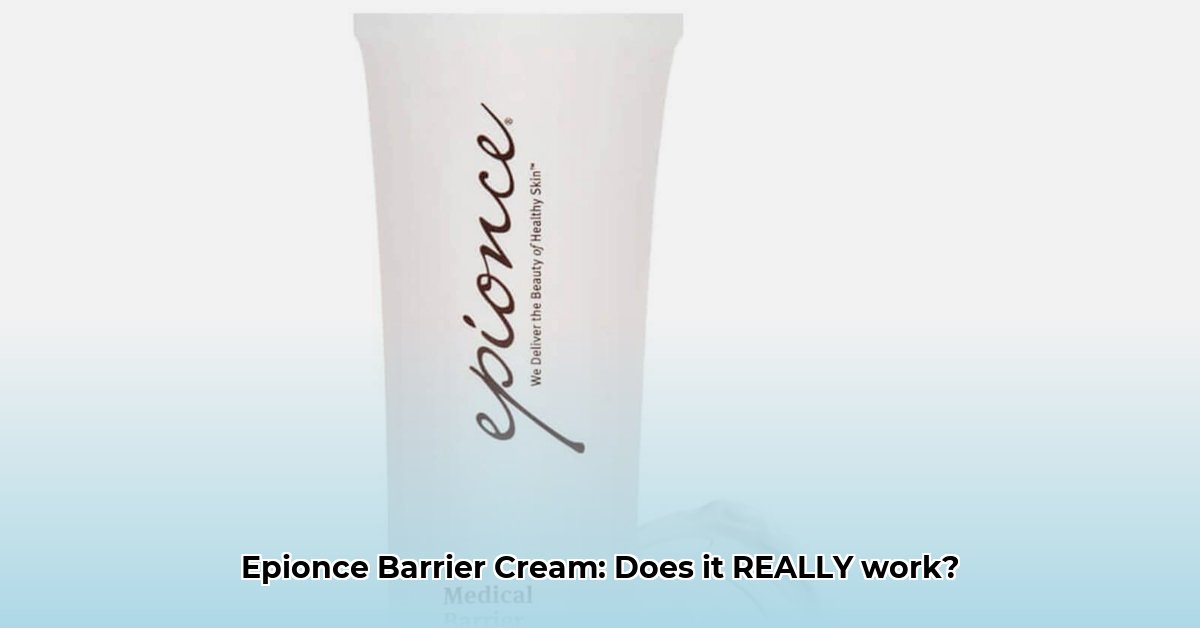So, you’re curious about Epionce Medical Barrier Cream? Lots of people are raving about it, but is all the buzz legit? We’ve dug into real customer reviews, examined the ingredients, and explored expert opinions to provide you with a comprehensive guide. For information on insurance coverage for dermatological treatments, see this helpful resource. We’ll share firsthand accounts of how it works, delve into the science behind the formula, discuss potential concerns, and offer tips to ensure safe and effective use. This review aims to provide a balanced perspective on Epionce Medical Barrier Cream, helping you determine if it suits your unique skincare needs.
Epionce Medical Barrier Cream: Real Results & Customer Experiences
Epionce Medical Barrier Cream has gained popularity for its promise of soothing and repairing sensitive skin. But does it live up to the hype? Let’s examine user experiences, available research, and expert insights to understand its efficacy in restoring and maintaining skin barrier function.
What People Are Saying About Epionce Medical Barrier Cream
A wealth of online reviews suggests positive user experiences. Many report improvements in skin texture, reduced redness, and enhanced hydration. Several customers emphasize its effectiveness in alleviating dryness and irritation, leading to improved skin hydration levels. While these firsthand accounts aren’t substitutes for scientific evidence, they provide valuable insights into how the cream performs in real-world scenarios, demonstrating its potential for personalized skincare.
One enthusiastic user shared, “My skin feels incredibly soft and hydrated since using this cream. The redness I struggled with for years is finally calming down.” Another noted, “This cream has been a game-changer for my dry, flaky skin. It’s the only thing that has provided lasting relief.” These testimonials, representative of numerous similar accounts, portray a product that can significantly improve skin comfort and appearance.
Diving Into the Science: Ingredients and Their Potential
While direct clinical trials on Epionce Medical Barrier Cream may be limited, exploring the science behind its key ingredients offers valuable insights. Epionce products often feature botanical extracts and emollients known for their skin-soothing and hydrating properties. Key ingredients often include:
- Safflower Seed Oil: Rich in linoleic acid, helps to strengthen the skin’s barrier and reduce moisture loss.
- Meadowfoam Seed Oil: Provides emollient properties, leaving skin feeling soft and smooth.
- Avocado Oil: Contains vitamins and antioxidants that can help nourish and protect the skin.
These ingredients are designed to work synergistically to support the skin’s natural barrier, protecting it from environmental aggressors and promoting improved skin health. Examining the scientific literature on these individual ingredients can shed light on their potential benefits for sensitive and compromised skin.
Addressing the Evidence Gap: A Call for More Research
Despite positive anecdotal evidence and the potential benefits of its individual ingredients, it’s important to acknowledge the limited availability of independent clinical trials specifically evaluating Epionce Medical Barrier Cream. While the lack of rigorous studies doesn’t necessarily negate the user-reported benefits, it does make it challenging to definitively confirm the cream’s effectiveness and understand its long-term effects. Further research is needed to provide a more comprehensive understanding of its benefits and efficacy.
Important Precautions: Patch Testing and Professional Advice
Prior to incorporating any new skincare product into your routine, especially if you have sensitive skin, a patch test is always recommended. Apply a small amount of the cream to a discreet area, such as your inner arm, and observe for 24-48 hours for any signs of sensitive skin reactions like redness, itching, or irritation. If you have pre-existing skin conditions like eczema, rosacea, or allergies, consult a dermatologist or qualified skincare professional before using Epionce Medical Barrier Cream. They can provide personalized recommendations based on your specific skin type and concerns.
Balancing Perspectives: Weighing Benefits and Limitations
Epionce Medical Barrier Cream has garnered considerable praise from users who have experienced significant improvements in their skin’s hydration, texture, and overall comfort. The formula’s focus on skin-nourishing ingredients and its potential to support the natural skin barrier is appealing. However, the limited availability of independent clinical trials necessitates a balanced approach. Consider your individual skin needs, sensitivities, and preferences when determining whether this cream is right for you.
Recommendations: A Holistic Approach
To maximize the potential benefits and minimize potential risks, consider the following recommendations regarding Epionce skincare products:
For Consumers:
- Prioritize patch testing: This is crucial to identify potential sensitivities or allergic reactions.
- Introduce gradually: Incorporate the cream slowly into your routine, allowing your skin to adapt.
- Observe your skin: Pay close attention to how your skin responds and discontinue use if any adverse reactions occur.
For Dermatologists and Skincare Professionals:
- Evaluate individual needs: Assess patients’ skin types, sensitivities, and concerns before recommending the cream.
- Integrate into a comprehensive regimen: Consider how the cream complements other skincare products and treatments.
- Educate patients: Provide information about the cream’s ingredients, potential benefits, and limitations.
For Epionce:
- Invest in clinical trials: Conduct independent studies to validate the cream’s effectiveness and safety.
- Enhance transparency: Provide comprehensive ingredient lists and detailed information about the sourcing and manufacturing processes.
Ultimately, Epionce Medical Barrier Cream presents potential, supported by positive user experiences and the science behind its ingredients. However, responsible decision-making requires a measured approach, combining personal judgment with professional guidance.
How to Determine Epionce Skincare Efficacy Without Clinical Trials
Key Takeaways:
- User testimonials suggest that Epionce Medical Barrier Cream may improve skin texture, hydration and overall comfort.
- The limited availability of clinical trials necessitates a careful evaluation of individual ingredients, user experiences, and potential risks.
- Patch testing and consulting a dermatologist are essential before incorporating the cream into your skincare routine.
The Challenge: Evaluating Epionce Without Extensive Data
Determining the effectiveness of a skincare product without rigorous clinical trials can seem daunting. However, by employing a multifaceted approach, you can still reach a well-informed decision regarding Epionce Medical Barrier Cream. This involves examining user feedback, analyzing ingredient lists, and assessing potential risks to determine how to determine Epionce skincare efficacy without clinical trials.
Leveraging User Feedback: Real-World Insights
The experiences of other users can offer valuable insights into how a product performs in real-world conditions. Search for detailed reviews that describe specific improvements in skin hydration, texture, and sensitivity. While anecdotal, consistent positive feedback from diverse sources can increase your confidence in the product’s potential. However, it’s important to remain objective and consider customer satisfaction impact with a critical eye.
Ingredient Analysis: Deciphering the Formula
A thorough examination of the ingredient list can provide clues about the cream’s potential benefits and drawbacks. Research the scientific literature on individual ingredients to understand their known properties and potential effects on the skin. Pay attention to ingredients known for their hydrating, soothing, and barrier-repairing properties, as well as any potential irritants or allergens. This helps to understand ingredient performance.
Unveiling Potential Drawbacks: Recognizing Limitations
No skincare product is without potential downsides. Be aware of potential side effects reported by users, such as skin irritation, redness, or allergic reactions. The absence of extensive clinical trials means that the full range of potential side effects may not be fully known. By acknowledging these potential side effects, you can make a more informed decision about whether the cream is right for you.
Informed Decision-Making: A Practical Guide
To navigate the uncertainties associated with limited clinical data, consider these practical steps:
- Prioritize Patch Testing: Apply a small amount of the cream to a discreet area for 24-48 hours to check for any adverse reactions, preventing adverse skin reactions.
- Scrutinize Reviews: Focus on detailed accounts that describe both positive and negative experiences.
- Seek Professional Advice: Consult a dermatologist to discuss your skin concerns and goals. They can assess your skin type, identify potential sensitivities, and recommend products that are suitable for your unique needs, minimizing skin irritation risks.
Embracing a Balanced Perspective: Empowering Informed Choices
Evaluating the efficacy of Epionce Medical Barrier Cream without extensive clinical trials requires a holistic approach. By combining user feedback, ingredient analysis, and professional guidance, you can reach an informed decision that aligns with your individual skincare needs and preferences, facilitating informed skincare choices.
Epionce Medical Barrier Cream for Sensitive Skin: A Comprehensive Guide
- Shop Bento Box for Sale To Find Your Ideal Lunch Container - December 6, 2025
- Lunch Box That Fits Bento Box Neatly for Daily Use - December 5, 2025
- Japanese Lunch Bag Does Double Duty as Bento Carrier and Tote - December 4, 2025










